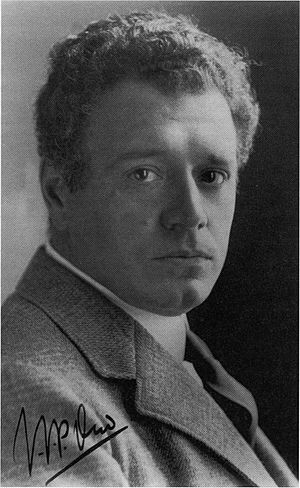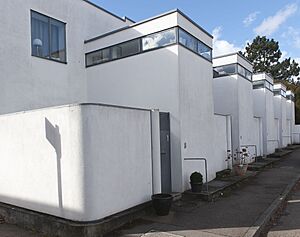Jacobus Oud facts for kids
Quick facts for kids
Jacobus Johannes Pieter Oud
|
|
|---|---|
 |
|
| Born | 9 February 1890 Purmerend, Netherlands
|
| Died | 5 April 1963 (aged 73) Wassenaar, Netherlands
|
| Nationality | Dutch |
| Occupation | Architect |
| Buildings | Weissenhof Estate Kiefhoek Housing Development |
Jacobus Johannes Pieter Oud, often known as J. J. P. Oud, was a famous Dutch architect. He was born on February 9, 1890, and passed away on April 5, 1963. He became well-known for being part of the De Stijl art and architecture movement.
Contents
Early Life and Start in Architecture
J. J. P. Oud was born in Purmerend, a town in the Netherlands. His father was a merchant who sold tobacco and wine. As a young architect, Oud was inspired by another famous architect named Berlage. He also studied for a while in Munich under Theodor Fischer.
Oud worked with W.M. Dudok in Leiden. There, he met Theo van Doesburg. This meeting led him to join the De Stijl movement.
Working for Rotterdam
Between 1918 and 1933, Oud became the Municipal Housing Architect for the city of Rotterdam. During this time, many workers were moving to the city. Oud focused on designing homes for these families. He worked on important housing projects in areas like Spangen, Kiefhoek, and the Witte Dorp.
Oud was one of many Dutch architects who tried to balance two things. He wanted to use smart, cost-effective building methods. But he also wanted to make sure the homes felt good and looked nice for the people living in them. He called his approach "poetic functionalism." This meant his buildings were useful but also had a touch of beauty.
International Recognition
In 1927, Oud was one of fifteen architects chosen for a very important exhibition. This was the modernist Weissenhof Estate exhibition in Germany. In America, Oud became famous for a short time. He was seen as one of the top modern architects. In 1932, he was considered one of the four greatest modern architects. The others were Ludwig Mies van der Rohe, Walter Gropius, and Le Corbusier.
Oud's work was shown in Philip Johnson's International Style exhibition. Johnson, a famous American architect, admired Oud's work. However, after World War II, some of Oud's later designs were criticized. People thought he used too much decoration, which went against the simple style of modernism.
Later Works and Legacy
After World War II, Oud designed several important buildings and monuments. He created the Dutch National War Monument in Amsterdam. He also designed the monument at the Military War Cemetery Grebbeberg. By this time, he had moved away from the strict rules of the De Stijl movement.
Oud continued to design buildings in his own unique style. Some of his later projects include the Spaarbank in Rotterdam. He also designed the office building De Utrecht in Rotterdam. Another notable work was the Children's health-centre in Arnhem.
Oud's brother, Pieter Oud, was the mayor of Rotterdam. J. J. P. Oud passed away in 1963 at the age of 73 in Wassenaar.
Key Projects
- 1918-1919: Worker housing in Spangen, Rotterdam.
- 1922: Garden Village in Rotterdam at Oud-Mathenesse.
- 1925: Café de Unie in Rotterdam.
- 1926-1927: Worker's Houses at the Hoek of Holland.
- 1927: A row of 5 houses for the Weissenhof Housing Exposition in Stuttgart.
- 1928-1930: Kiefhoek Housing Development in Rotterdam.
- 1938-1948: Shell Headquarters in The Hague.
- 1956: National Monument in Dam Square, Amsterdam (with sculptor John Raedecker).
Images for kids
See also
 In Spanish: Jacobus Johannes Pieter Oud para niños
In Spanish: Jacobus Johannes Pieter Oud para niños



